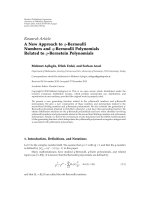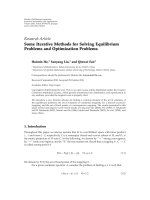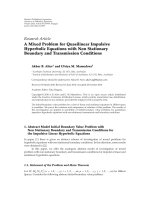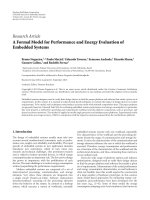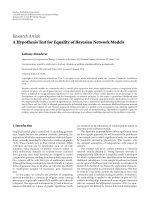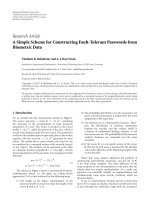Báo cáo hóa học: "Research Article A Geometrical-Based Model for Cochannel Interference Analysis and Capacity Estimation of CDMA Cellular Systems" pot
Bạn đang xem bản rút gọn của tài liệu. Xem và tải ngay bản đầy đủ của tài liệu tại đây (738.72 KB, 7 trang )
Hindawi Publishing Corporation
EURASIP Journal on Wireless Communications and Networking
Volume 2008, Article ID 791374, 7 pages
doi:10.1155/2008/791374
Research Article
A Geometrical-Based Model for Cochannel Interference
Analysis and Capacity Estimation of CDMA Cellular Systems
Konstantinos B. Baltzis
Section of Applied and Environmental Physics, Department of Physics, Aristotle University of Thessaloniki,
54124 Thessaloniki, Greece
Correspondence should be addressed to Konstantinos B. Baltzis,
Received 4 March 2008; Revised 7 June 2008; Accepted 5 August 2008
Recommended by Mohamed Hossam Ahmed
A common assumption in cellular communications is the circular-cell approximation. In this paper, an alternative analysis based
on the hexagonal shape of the cells is presented. A geometrical-based stochastic model is proposed to describe the angle of arrival
of the interfering signals in the reverse link of a cellular system. Explicit closed form expressions are derived, and simulations
performed exhibit the characteristics and validate the accuracy of the proposed model. Applications in the capacity estimation
of WCDMA cellular networks are presented. Dependence of system capacity of the sectorization of the cells and the base station
antenna radiation pattern is explored. Comparisons with data in literature validate the accuracy of the proposed model. The
degree of error of the hexagonal and the circular-cell approaches has been investigated indicating the validity of the proposed
model. Results have also shown that, in many cases, the two approaches give similar results when the radius of the circle equals to
the hexagon inradius. A brief discussion on how the proposed technique may be applied to broadband access networks is finally
made.
Copyright © 2008 Konstantinos B. Baltzis. This is an open access article distributed under the Creative Commons Attribution
License, which permits unrestricted use, distribution, and reproduction in any medium, provided the original work is properly
cited.
1. INTRODUCTION
Wireless communications become more and more popular
in our daily life. This impressive evolution imposes a
series of challenges. Networks are asked to deal with a
multimedia traffic mix of voice, data, and video, each having
different transfer requirements while demands on capacity
always increase [1]. A major challenge for engineers is the
development of realistic models that can efficiently estimate
the performance of wireless systems. Among the various
performance degradation factors, cochannel interference
(CCI) is quite significant especially since cells in a cellular
system tend to be denser for capacity reasons [2].
The development of models that describe CCI is of
great interest nowadays. Reliable models can be found in
the published literature; see, for example, [3–6]. However,
their complexity and computational cost bounds their
application. Nevertheless, simple geometrical-based models
have been developed allowing approximate but adequate
system performance estimation; see, for example, [7–11]. A
simple approach is presented in [7]. There, the estimation of
the reverse link performance degradation due to CCI is based
on the calculation of the probability density function (pdf) of
the angle of arrival (AoA) of the interfering signals at the base
station (BS). The circular-cell approximation is the main
assumption of the approach, an assumption quite common
in cellular systems [12]. This approximation is usually valid
despite the circular cells must partially overlap in order to
avoid gaps, [13]; however, in some cases it gives poor results;
see, for example, [14].
In this paper, a proposal that extends the model in [7]
by considering the hexagonal shape of the cells is presented.
The main benefit of the proposed model is the increased
accuracy comparing to [7], as well, its simplicity and low-
computational cost compared to deterministic and nonge-
ometrical models. Simple closed form expressions for the
statistics of the AoA of the interfering signals in the reverse
link of cellular systems, when the closest edges of two cells
are properly aligned, are provided. Performance evaluation
is based on the calculation of the average probability that the
2 EURASIP Journal on Wireless Communications and Networking
2nd tier of co-channel
interfering cells
1st tier of co-channel
interfering cells
r
R
D
Figure 1: Typical hexagonal cell pattern (cluster size is one).
desired signal does not exceed CCI by a specific protection
ratio (outage probability).
The paper is organized as follows. The system geometry
and the assumptions made are presented in Section 2.
In Section 3, the proposed model is described. Numerical
examples and discussions are provided in Section 4.Con-
cluding remarks are finally drawn in Section 5.
2. SYSTEM GEOMETRY AND MAIN ASSUMPTIONS
A cellular system hexagonal cell pattern with cluster size K
=
1isillustratedinFigure 1. The distance between the centers
of two cochannel cells is D. The inradius and circumradius
of the hexagonal cells are denoted with R and r,respectively.
A single line-of-sight signal path between each interferer and
the desired BS is considered. BSs are located at the centers of
the cells, and the mobiles are uniformly distributed within
the cells. The model assumes only the first ring of cochannel
interferers. The environment is interference-limited, that is,
CCI is the only limiting factor of performance [15]. For
simplicity, a conventional downlink beamforming scheme
(i.e., each BS main beam is aimed directly toward the desired
mobile user) is assumed.
3. MATHEMATICAL FORMULATION
In the geometrical-based model proposed in [7], the cells are
approximated as circles with radius ρ. The pdf of the AoA of
the interfering signals in the reverse link is
f
c
(φ) =
2D
πρ
cosφ
1 −
D
ρ
2
sin
2
φ
·U
sin
−1
ρ
D
−|
φ|
,
(1)
where U(x) is the unit step function. For brevity reasons,
the analysis of the circular-cell approach is not repeated. This
model is extended here by considering the hexagonal shape
of the cells. The analysis applied to the case when the closest
BCFG P
J
K
L
O
M
DEHT N
D
ϕ
ϕ
3
ϕ
2
ϕ
1
A
r
R
BS
0
BS
i
Figure 2: Proposed hexagonal model.
edges of two cochannel cells are properly aligned (e.g., a
hexagonal structure with cluster size one, see Figure 1). Since
the users are assumed to be uniformly distributed within
the cell, the probability of the AoA of the interfering signals
at the BS is proportional to the area E(φ) of the polygon
defined from the axis that connects the BSs of the desired
and the interfering cell, BS
0
and BS
i
, respectively, the line
segment determined from the angle φ, and the boundaries
of the interfering cell; see Figure 2. In general,
∀D : D ≥ 2R,
three different subregions determined by the angles
φ
i
= cot
−1
√
3D
μ
i
R
+ λ
i
, i = 1, 2,3 (2)
with μ
={1, 1,2} and λ ={
√
3, −
√
3, 0} are defined.
Obviously, for
|φ|≤φ
1
,itis
E
1
(φ) ≡ E(BCDE) = E(ABC) −E(ADE), (3)
where E(X
1
X
2
···X
q
) is the area of the q-sided polygon
X
1
X
2
···X
q
.Itis
E(ABC)
=
1
2
(D + R)
BC =
1
2
(D + R)
2
tan φ,
E(ADE)
=
1
2
(D
−R)DE =
1
2
(D
−R)
2
tan φ,
(4)
where
X
1
X
2
is the length of the line segment with endpoints
X
1
and X
2
.Itisfinally
E
1
(φ) = 2RD tan φ. (5)
Konstantinos B. Baltzis 3
For φ
1
≤|φ|≤φ
2
,itis
E
2
(φ) ≡ E(FGHI)
= E(ABG) −
E
1
φ
1
+ E(ADI) + E(FGJ)
(6)
with
E(BGA)
=
1
2
(D + R)
BG =
1
2
(D + R)
2
tan φ,
E(ADI)
=
1
2
(D
−R)DI =
1
2
(D
−R)
2
tan φ.
(7)
Using the angle-angle-side (AAS) theorem [16], after some
manipulation we get
E(FGJ)
=
sin(π/3) sin(π/2 −φ)
2 sin(π/6+φ)
·(R + D)
2
(tan φ −tan φ
1
)
2
.
(8)
Therefore, (6)gives
E
2
(φ) = 2DR(tan φ −tanφ
1
)
−
√
3(D + R)
2
2
·
(tan φ −tan φ
1
)
2
1+
√
3tanφ
.
(9)
Similarly, for φ
2
≤|φ|≤φ
3
,itis
E
3
(φ) ≡ E(KLMN)
=
A
2
−
E
1
φ
1
+ E
2
φ
2
+ E(LMO)
,
(10)
where A
= 2
√
3R
2
the area of the hexagon, and
E(LMO)
=
sin(2π/3) sin(π/6+φ)
2sin(π/6 −φ)
·LO
2
=
√
3sin(π/6+φ)
4sin(π/6 −φ)
r −FL
2
.
(11)
It is also
FL
sin(π/2 −φ)
=
FP
sin(π/6+φ)
=⇒ FL =
2
1+
√
3tanφ
FP
(12)
with
FP = BP −BF = (R + D)(tan φ −tan φ
1
). (13)
Using (10)–(13), E
3
(φ) is calculated as
E
3
(φ) =
√
3R
2
−
E
1
φ
1
+ E
2
φ
2
+
R+
√
3(D + R)tanφ
1
−
√
3D tan φ
2
√
3
1 −3tan
2
φ
.
(14)
Since the users are uniformly distributed within the hexago-
nal cell, their density f
area
is inversely proportional to the area
of the hexagon. The cumulative distribution function (cdf)
of the incoming interfering signals is given by
F(φ)
= f
area
E(φ) =
3
i=1
E
i
(φ)
A
. (15)
Differentiation of (15) gives the pdf of the AoA of the
interfering signals. It is
f (φ)
=
⎧
⎪
⎪
⎪
⎪
⎪
⎪
⎪
⎪
⎪
⎪
⎪
⎪
⎪
⎪
⎪
⎪
⎪
⎪
⎪
⎪
⎪
⎪
⎪
⎪
⎪
⎪
⎪
⎪
⎪
⎪
⎪
⎪
⎪
⎪
⎪
⎪
⎪
⎪
⎨
⎪
⎪
⎪
⎪
⎪
⎪
⎪
⎪
⎪
⎪
⎪
⎪
⎪
⎪
⎪
⎪
⎪
⎪
⎪
⎪
⎪
⎪
⎪
⎪
⎪
⎪
⎪
⎪
⎪
⎪
⎪
⎪
⎪
⎪
⎪
⎪
⎪
⎪
⎩
D
√
3R
sec
2
φ, |φ|≤φ
1
,
⎧
⎪
⎪
⎪
⎪
⎪
⎪
⎪
⎪
⎨
⎪
⎪
⎪
⎪
⎪
⎪
⎪
⎪
⎩
D
√
3R
−
1
4
1+
D
R
2
×
(tan |φ|−tanφ
1
)
1+
√
3tan|φ|
2
×
2+
√
3(tan |φ|+tanφ
1
)
⎫
⎪
⎪
⎪
⎪
⎪
⎪
⎪
⎪
⎬
⎪
⎪
⎪
⎪
⎪
⎪
⎪
⎪
⎭
·
sec
2
φ,
φ
1
≤|φ|≤φ
2
,
−
R +
√
3(D + R)tanφ
1
−
√
3D tan|φ|
√
3[R
1 −3tan
2
φ
]
2
×
−D +
√
3
R +
√
3(D + R)tanφ
1
×
tan |φ|
·sec
2
φ, φ
2
≤|φ|≤φ
3
,
0,
|φ| >φ
3
(16)
for any D>2R. When D
= 2R (or equivalently K = 1), (16)
is simplified into
f (φ)
=
⎧
⎪
⎪
⎪
⎪
⎪
⎪
⎪
⎪
⎪
⎪
⎪
⎪
⎪
⎪
⎪
⎪
⎪
⎪
⎪
⎨
⎪
⎪
⎪
⎪
⎪
⎪
⎪
⎪
⎪
⎪
⎪
⎪
⎪
⎪
⎪
⎪
⎪
⎪
⎪
⎩
2
√
3
sec
2
φ, |φ|≤tan
−1
1
3
√
3
,
⎧
⎪
⎪
⎨
⎪
⎪
⎩
2
√
3
−
9
4
(tan
|φ|−tan φ
1
)
1+
√
3tan|φ|
2
×
2+
√
3(tan |φ|+tanφ
1
)
⎫
⎪
⎪
⎬
⎪
⎪
⎭
·
sec
2
φ,
tan
−1
1
3
√
3
≤|
φ|≤
π
6
,
0,
|φ| >
π
6
.
(17)
For a given φ, the probability that a particular user is
causing interference is
P(φ)
= G(φ) ⊗ f (φ), (18)
where G(φ) is the desired BS antenna radiation pattern, and
⊗ is the convolution operator. The average probability of
outage of CCI is [7]
P(outage)
=
def
P(CIR <γ)
=
N
n=1
P
Z
d
< 0 | n
P(n),
(19)
4 EURASIP Journal on Wireless Communications and Networking
where CIR is the carrier to interference ratio (CIR), P(n)is
the average probability over φ that n out of the possible N
interfering cells are causing interference, γ is the protection
ratio, Z
d
is the carrier to interference plus protection ratio
(CIPR), and P(Z
d
< 0 | n) is the conditional probability of
outage given n interferers assuming combined Rayleigh and
Lognormal fading [7, 8].
4. NUMERICAL RESULTS AND DISCUSSIONS
In this Section, results of the numerical evaluation of the
proposed model are presented. The accuracy of the proposed
model and the circular-cell approximation is examined in
detail. The impact of the BS antenna radiation pattern and
the sectorization of the cells on the reverse link performance
of a WCDMA cellular system are also investigated.
The first two sets of results presented are the pdfs and
the cdfs of the AoA of the interfering signals at the desired
BS. Using (1), (16), and (17), the pdfs for cellular systems
with D
= 2R (typical value for WCDMA systems) and
D
= 5R are evaluated for both the proposed model and
the circular-cell approximation and presented in Figure 3.In
the circular-cell approximation, cell radius is equal to the
inradius (ρ
= R) or to the circumradius (ρ = r)ofthe
hexagonal cell. For brevity reasons, they will be mentioned
as inradius and circumradius approximation (approach),
respectively. There are significant differences in the curves
for φ
∼
=
0andgreatvaluesofφ. The inradius approximation
gives results closer to the hexagonal-cell approach. Note that
arg max
φ
f (φ)
/
=0, that is, the argument of the maximum
of f
c
(φ). It easily comes that ∀D : D ≥ 2R the absolute
relative difference in the pdf value at φ
= 0 between the
circular-cell approximation and the proposed model is 4.7%
if ρ
= R, and 10.3% when ρ = r. Integrating (1), (16), and
(17), the corresponding cdfs are calculated and illustrated
in Figure 4.Noticeabledifferences are observed between the
three approaches. Again, the inradius approximation gives
results closer to the hexagonal-cell approach.
The probability that an interfering cell is causing interfer-
ence over φ is illustrated in Figure 5. Two WCDMA cellular
systems have been considered. In the first case, six-sectored
cells using directional antennas with half-power beamwidth
HP
= 65
◦
are used. In the second, a narrow beam BS antenna
(HP
= 10
◦
) is assumed. In both cases, BS antenna radiation
patterns are in the form of cosφ with sidelobe level
−15 dB,
typical measured values for WCDMA networks [17, 18]. As
φ approaches zero differences are observed, mainly in the
narrow beam system (P(φ) in the proposed model is smaller
about 7% and 21% compared to the inradius and the cir-
cumradius approaches, resp.). Differences are also observed
at angles point at the edges of the interfering cell. However, in
the six-sectored configuration, the inradius approximation
gives adequate results. It may also be concluded, due to lower
probability of interference, that performance degradation
due to CCI is smaller in the narrow beam system compared
to the six-sectored one.
Moreover, the calculated values of pdfs and cdfs show the
differences between the proposed model and the circular-
cell approximations. Noticeable differences are observed at
403020100−10−20−30−40
ϕ (deg)
0
0.5
1
1.5
2
2.5
3
3.5
Probability density function (ϕ)
D = 5R
D
= 2R
Hexagonal cell
Circular cell (ρ
= R)
Circular cell (ρ
= r)
Figure 3: Pdf of the AoA of the interfering signals at the desired
base station.
403020100
ϕ (deg)
0
0.25
0.5
0.75
1
1.25
Cummulative distribution function (ϕ)
D = 5RD= 2R
Hexagonal cell
Circular cell (ρ
= R)
Circular cell (ρ
= r)
Figure 4: Cdf of the AoA of the interfering signals at the desired
base station.
small angles and at Φ
∼
=
sin
−1
(P/D). However, in narrow
beam systems, significant differences are observed in the
calculation of the probability of interference also.
In order to validate the accuracy and reliability of the
models, simulation results are presented. The pdfs in (1)
and (17)areevaluatedforatestcaseofasingleclustersize
WCDMA system. Shadow fading is modeled as an indepen-
dent log-normally distributed multiplicative noise on the
signal strength received from the BS combining Rayleigh and
Lognormal fading [7, 8]. Users density function is defined as
in [19]. Reverse link chip rate is 3.84 Mchips/ sec. Rest of the
Konstantinos B. Baltzis 5
180120600−60−120−180
ϕ (deg)
0
0.2
0.4
0.6
0.8
1
P(ϕ)
Six-sectored system
Narrow-beam system
Hexagonal cell
Circular cell (ρ
= R)
Circular cell (ρ
= r)
Figure 5: Probability that an interfering cell is causing interference
over φ.
Table 1: Pdfs values: simulated estimation errors.
Hexagonal model Circular model
ρ
= Rρ= r
e
f
ε
f
e
f
ε
f
e
f
ε
f
1.48% 1.87% 8.17% 10.40% 9.76% 20.36%
system parameters is similar to the ones in [20]. In Tabl e 1 ,
the mean absolute estimation error defined as
e
f
=
1
N
N
i=1
f
[i]
sim
− f
[i]
(20)
and the mean relative estimation error given from
ε
f
=
1
N
N
i=1
f
[i]
sim
− f
[i]
f
[i]
sim
(21)
are presented. With f
[i]
is denoted the analytically derived
pdf and with f
[i]
sim
its simulated value. Results are calculated
by carrying out 1000 Monte Carlo trials. The simulated
results closely match the theoretical pdf of (17). On the
other hand, significant differences are observed between the
simulated and the circular-cell approximations results. It
has to be mentioned that the inradius approximation gives
results closer to the simulated values.
In Ta ble 2, the simulated and the analytically derived
results of (1), (17), and (18) are compared. Two system
architectures, the six-sectored and the narrow beam one
(details are given in previous paragraph), are considered. The
rest of the system parameters are as previously defined. The
mean absolute,
e
P
, and the mean relative, ε
P
, estimation
errors are defined from (20)and(21) substituting f
[i]
and
f
[i]
sim
with P
[i]
and P
[i]
sim
, that is, the values of probability of
interference that respond to ith snapshot of the analytically
403020100−10
CIPR (dB)
10
−5
10
−4
10
−3
10
−2
10
−1
10
0
P (outage)
Omni
HP
= 120
◦
HP= 65
◦
HP= 30
◦
HP= 20
◦
HP= 10
◦
HP= 5
◦
Figure 6: Plot of outage curves as a function of CIPR for flattop
beamformers of various beamwidths. The outage curve of an
omnidirectional antenna is also presented.
derived and the simulated probability, respectively. In the six-
sectored network, a good agreement is observed between the
theoretical and the simulated results for all models. However,
in the narrow beam configuration, significant differences are
found. The worst results are obtained with the circumradius
approximation.
Next, the dependence of a WCDMA system performance
on the BS antenna radiation pattern characteristics and the
cells sectorization is investigated. Without loss of generality,
the users activity level and the protection ratio are assumed
P
= .4andγ = 8 dB. The outage curves as a function
of CIPR are shown in Figure 6. In the simulations, the
mobile’s signal is received by flattop beamformers of various
beamwidths or an omnidirectional BS antenna. Decrease
in the beamformer’s beamwidth up to a point reduces
significantly the outage probability of CCI, indicating the
improved performance obtained by sectorization and the
use of narrow beam antennas. Typical values of CIR at
the input of the receiver in the reverse link of a WCDMA
system are usually close to 7 dB [21, 22]. The maximum
acceptable outage probability is set at 10
−2
for voice and
video transmission, and 10
−3
for web browsing and data
[23]. As shown in Figure 6, voice and video transmission
is possible when beamformers with beamwidths lower than
20 degrees are used. However, model predictions about web
browsing and data transmission are pessimistic.
In Figure 7, the relative gains between systems with
different BS antenna radiation patterns are presented. The
relative gain is defined as
Relative gain (dB)
= CIPR
1
−CIPR
2
, (22)
where CIPR
1(2)
are the CIRPs for two systems with the
same outage probability. An omnidirectional antenna and
6 EURASIP Journal on Wireless Communications and Networking
Table 2: Probability of interference values: simulated estimation errors.
System architecture
Hexagonal model Circular model
ρ
= Rρ= r
e
P
ε
P
e
P
ε
P
e
P
ε
P
Six-sectored system 0.59% 1.18% 1.34% 2.03% 1.86% 2.54%
Narrow beam system 0.47% 2.51% 1.19% 5.77% 3.99% 19.35%
10
−1
10
−2
10
−3
10
−4
10
−5
10
−6
P (outage)
−25
−20
−15
−10
−5
0
Relative gain (dB)
Omni/120
◦
Omni/65
◦
Omni/10
◦
120
◦
/65
◦
120
◦
/10
◦
65
◦
/10
◦
Figure 7: Relative gain versus P (outage) for flat-top beamformers
of various beamwidths. The case of an omni-directional antenna is
also considered.
flattop beamformers with beamwidths equal to 120, 65, and
10 degrees are considered. Beamwidth reduction improves
significantly system performance. Also, notice that the
relative gain is constant for outage probabilities smaller than
1%. Assuming that CIR is approximately reciprocal to the
maximum number of users [21], it can be shown that the
ratio of the maximum number of users in the two systems is
given by
Λ
∼
=
10
−Relative gain (dB)/10
. (23)
For example, from Figure 7, it can be shown, using (23), that
the maximum number of users allowed in a six-sectored cell
to the ones in a system with an omnidirectional antenna
is almost five times greater (Λ
∼
=
4.8∼4.9). Capacity in
terms of the maximum number of users allowed is doubled
when using a narrow beam beamformer with beamwidth
equalto10degrees.SimilarresultsarederivedfromFigure 6
in [22] for multirate single cell CDMA wireless local loop
systems. As a further example, let us consider [8, Figure 4].
When D
= 2R, the ratio of outage probabilities between two
systems with BS antennas beamwidths 10 and 20 degrees and
SLL
=−10 dB is almost 1.3. From Figure 6 and beamformers
with similar beamwidths, this ratio takes the same value (for
CIPR that gives outage probability close to 10%).
A major advantage of the proposed model is its low-
computational cost. In general, geometrically-based models
used for the description of CCI are determined by the
users’ distribution within the cell. In a stochastic model,
such as the one proposed here, the users positions are
chosen stochastically according to a certain probability
distribution. Similar models are also used in propagation
channel modeling; see, for example, [24]. Advantages of
these models are the physical insight they provide and their
low computational cost. In general, the results they provide
are adequate if one considers their reduced complexity.
This paper refers to WCDMA networks; however, the
analysis presented here is valid for any single cluster size
system (or for cellular geometries, where the closest edges of
the two cells are properly aligned), for example, the OFDMA
(WiMAX) systems or even the ad hoc networks [1, 25, 26].
Especially in MIMO-OFDM, the single cluster size networks
may be loaded much further than other architectures [27].
In WiMAX systems, resources are allocated on both time
and frequency bases and adjacent cells using subcarriers
of exactly the same frequency and time cause interference
that takes the form of collisions [28]. A suggestion on how
the technique can be applied to these systems involves an
extension of the model in the time domain. A simple idea
may consider a joint pdf f (φ, τ)
= f
φ
(φ) f
τ
(τ | φ), where
f
φ
(φ)isgivenfrom(17), and f
τ
(τ | φ) is the conditional pdf
of τ for a given φ associated with the probability of collisions
in a subcarrier [29].
5. CONCLUSIONS
In this paper, a geometrical-based model is proposed to
describe the cochannel interference in a cellular system when
the cluster size is one or the closest edges of two cells
are properly aligned. The model considers the hexagonal
shape of the cells. It is applied for the study of performance
degradation due to CCI and capacity estimation of the
reverse link of single cluster size systems. Analytically derived
closed form expressions that provide the statistics of the
AoA of the interfering signals at the BS have been provided.
Model characteristics and comparisons with the circular-
cell approach are presented. Simulations performed have
validated the accuracy of the model. In many cases, the
results derived from the hexagonal model and the inradius
circular approach were similar. The dependence of the
capacity of a WCDMA network on cells sectorization and
BS antenna radiation pattern has also been studied. Cells
sectorization and use of narrow beam BS antennas increase
Konstantinos B. Baltzis 7
significantly the capacity of a cellular system. Suggestions on
how the technique can be applied to WiMAX systems are
finally made.
REFERENCES
[1] W. Webb, Wireless Communications: The Future, John Wiley &
Sons, Chichester, UK, 2007.
[2] P. Stavroulakis, Interference Analysis and Reduction for Wireless
Systems, Artech House, Norwood, Mass, USA, 2003.
[3] S. J. Grant and J. K. Cavers, “System-wide capacity increase for
narrowband cellular systems through multiuser detection and
base station diversity arrays,” IEEE Transactions on Wireless
Communications, vol. 3, no. 6, pp. 2072–2082, 2004.
[4] A. Masmoudi and S. Tabbane, “Other-cell-interference factor
distribution model in downlink WCDMA systems,” Wireless
Personal Communications, vol. 36, no. 3, pp. 245–275, 2006.
[5] S. Venkatesan, “Coordinating base stations for greater uplink
spectral efficiency in a cellular network,” in Proceedings of the
18th International Symposium on Personal, Indoor and Mobile
Radio Communications (PIMRC ’07), pp. 1–5, Athens, Greece,
September 2007.
[6] S. Karimifar and J. K. Cavers, “Achieving high-capacity
narrowband cellular systems by means of multicell nultiuser
detection,” IEEE Transactions on Vehicular Technology, vol. 57,
no. 2, pp. 945–953, 2008.
[7] P. Petrus, R. B. Ertel, and J. H. Reed, “Capacity enhancement
using adaptive arrays in an AMPS system,” IEEE Transactions
on Vehicular Technology , vol. 47, no. 3, pp. 717–727, 1998.
[8] W. S. Au, R. D. Murch, and C. T. Lea, “Comparison between
the spectral efficiency of SDMA systems and sectorized
systems,” Wireless Personal Communications,vol.16,no.1,pp.
51–67, 2001.
[9] Z. Zufan, W. Shihong, Y. Jing, and Z. Lianxiang, “CIR
performance analysis and optimization of a new mobile
communication cellular configuration,” in Proceedings of the
4th International Conference on Microwave and Millimeter
Wave Technology (ICMMT ’04), pp. 826–829, Beijing, China,
August 2004.
[10] Z. Zufan, L. Fang, and D. Huiping, “More realistic analysis
of co-channel interference in sectorization cellular commu-
nications systems with Rayleigh fading environment,” in
Proceedings of the 2nd International Conference on Wireless
Communications, Networking and Mobile Computing (WiCOM
’06), pp. 1–5, Wuhan, China, September 2006.
[11] A. D. Panagopoulos, T. D. Kritikos, and J. D. Kanellopou-
los, “Adaptive uplink power control in adjacent DVB-RCS
networks: interference statistical distribution,” in Proceedings
of the 18th International Symposium on Personal, Indoor and
Mobile Radio Communications (PIMRC ’07), pp. 1–4, Athens,
Greece, September 2007.
[12] A. Goldsmith, Wireless Communications, Cambridge Univer-
sity Press, New York, NY, USA, 2005.
[13] S. Jivkova and M. Kavehrad, “Transceiver design concept for
cellular and multispot diffusing regimes of transmission,”
EURASIP Journal on Wireless Communications and Network-
ing, vol. 2005, no. 1, pp. 30–38, 2005.
[14] S. W. Oh and K. H. Li, “Evaluation of forward-link perfor-
mance in cellular DS-CDMA with Rayleigh fading and power
control,” International Journal of Communication Systems, vol.
14, no. 3, pp. 243–250, 2001.
[15] N. C. Sagias, “Closed-form analysis of equal-gain diversity
in wireless radio networks,” IEEE Transactions on Vehicular
Technology, vol. 56, no. 1, pp. 173–182, 2007.
[16] E. W. Weisstein, CRC Concise Encyclopedia of Mathematics,
Chapman & Hall/CRC, Boca Raton, Fla, USA, 2nd edition,
2002.
[17] L. E. Br
˚
aten, M. Pettersen, and A. Spilling, “An evaluation
of adaptive arrays for a UMTS FDD network deployed in a
suburban area of Norway,” in Proceedings of the 14th IEEE
International Symposium on Personal, Indoor and Mobile Radio
Communications (PIMRC ’03), vol. 3, pp. 2353–2357, Beijing,
China, 2003.
[18] J. Niemel
¨
a, T. Isotalo, and J. Lempi
¨
ainen, “Optimum
antenna downtilt angles for macrocellular WCDMA network,”
EURASIP Journal on Wireless Communications and Network-
ing, vol. 2005, no. 5, pp. 816–827, 2005.
[19]M.Jordan,M.Senst,Y.Cui,G.Ascheid,andH.Meyr,
“Downlink based intercell time synchronization using max-
imum likelihood estimation,” in Proceedings of the 16th IST
Mobile and Wireless Communications Summit, Mediterranean
Microwave Symposium, pp. 1–5, Budapest, Hungary, July 2007.
[20] I. A. Aldmour, K. Al-Begain, and A. I. Zreikat, “Uplink
capacity/coverage analysis of WCDMA with switched beam
smart antennae,” Wireless Personal Communications, vol. 43,
no. 4, pp. 1705–1715, 2007.
[21] K. S. Gilhousen, I. M. Jacobs, R. Padovani, A. J. Viterbi,
L. A. Weaver Jr., and C. E. Wheatley III, “On the capacity
of a cellular CDMA system,” IEEE Transactions on Vehicular
Technology, vol. 40, no. 2, pp. 303–312, 1991.
[22] Y. Zhou, F. Chin, Y C. Liang, and C C. Ko, “Capacity
of multirate multicell CDMA wireless local loop system
with narrowbeam antenna and SINR based power control,”
International Journal of Wireless Information Networks, vol. 8,
no. 2, pp. 99–108, 2001.
[23] C. Nie, T. C. Wong, and Y. H. Chew, “Outage analysis
for multi-connection multiclass services in the uplink of
wideband CDMA cellular mobile networks,” in Proceedings
of the 3rd International IFIP-TC6 Networking Conference
(NETWORKING ’04), vol. 3042 of Lecture Notes in Computer
Science, pp. 1426–1432, Athens, Greece, May 2004.
[24] P. Almers, E. Bonek, A. Burr, et al., “Survey of channel
and radio propagation models for wireless MIMO systems,”
EURASIP Journal on Wireless Communications and Network-
ing, vol. 2007, Article ID 19070, 19 pages, 2007.
[25] K. Lu, Y. Qian, H H. Chen, and S. Fu, “WiMAX networks:
from access to service platform,” IEEE Network,vol.22,no.3,
pp. 38–45, 2008.
[26] J. G. Andrews, S. Weber, and M. Haenggi, “Ad hoc networks: to
spread or not to spread? [Ad hoc and sensor networks],” IEEE
Communications Magazine, vol. 45, no. 12, pp. 84–91, 2007.
[27] A. T
¨
olli and M. Juntti, “System level evaluation of space-
time coded MIMO-OFDM for wide area communications,” in
Proceedings of the 14th IST Mobile & Wireless Communications
Summit, pp. 1–5, Dresden, Germany, June 2005, paper 240.
[28] C. Tarhini and T. Chahed, “On capacity of OFDMA-based
IEEE802.16 WiMAX including adaptive modulation and cod-
ing (AMC) and inter-cell interference,” in Proceedings of the
15th IEEE Workshop on Local and Metropolitan Area Networks
(LANMAN ’07), pp. 139–144, Princeton, NJ, USA, June 2007.
[29] L. Sartori, S E. Elayoubi, B. Fouresti
´
e, and Z. Nouir, “On the
WiMAX and HSDPA coexistence,” in Proceedings of the IEEE
International Conference on Communications (ICC ’07),pp.
5636–5641, Glasgow, Scotland, June 2007.
